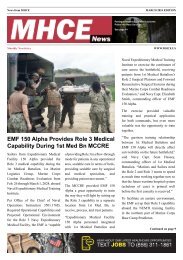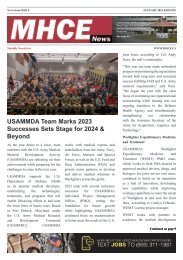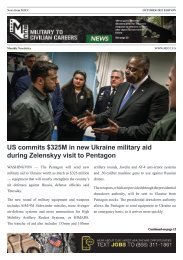May 2022 — MHCE Newsletter
Create successful ePaper yourself
Turn your PDF publications into a flip-book with our unique Google optimized e-Paper software.
14 | <strong>MHCE</strong> - News www.mhce.us MAY <strong>2022</strong> EDITION<br />
the program is being overwhelmed since classes are also available in live<br />
online, on-demand or hybrid formats.<br />
The urgency described by leaders who are putting their money toward<br />
keeping skilled service members is a sign of the worry about a brain<br />
drain.<br />
Unlike the broader enlistment bonuses, many military career fields don't<br />
offer cash for reenlistment, and some of these incentives existed prior to<br />
the pandemic. But the job market has put pressure on the services to pay<br />
up to keep service members in the force.<br />
Overweight and Hard to Reach<br />
The military's difficulties attracting recruits go far beyond making the<br />
right bonus offer. The forces working against recruiting increased during<br />
the grinding global pandemic -- lockdowns kept recruiters home and<br />
young Americans are refusing vaccines, for example -- and are also rooted<br />
in longer-term societal shifts in physical fitness and communication.<br />
"The aggregate effects of two years of COVID is that is two years of<br />
not being in high school classrooms, two years of not having air shows<br />
and major public events like being in those public spaces, where our<br />
potential applicants or potential recruits are getting personal exposure,<br />
face-to-face relationships with military recruiters," Thomas said.<br />
Only about 40% of Americans who are of prime recruiting age are<br />
vaccinated against the virus. Outright refusal to get the shot immediately<br />
precludes joining the force and short-circuits any pitch from recruiters.<br />
COVID vaccines are among at least a dozen inoculations mandated by<br />
the Defense Department.<br />
"Seventeen-to-24-year-olds are not getting vaccinated, and those [are]<br />
people we aren't having a conversation with," Vereen said.<br />
Even when potential recruits are interested and big bonuses motivate<br />
them to sign on the dotted line, only about 23% of young Americans are<br />
even eligible for service.<br />
Past legal run-ins or a drug history prevent potential recruits from<br />
joining, and more and more Americans are overweight. According to the<br />
Centers for Disease Control and Prevention, 40% of adults aged 20 to<br />
39 are obese. That problem has been deemed a national security risk by<br />
somebecause it causes an increasingly shallow pool of potential recruits.<br />
The confluence of challenges has others loudly alerting the public that<br />
there's a problem.<br />
Sen. Thom Tillis, R-N.C., the ranking member of the Senate Armed<br />
Services Committee personnel panel, says the military is on the cusp of<br />
a recruiting crisis.<br />
"To put it bluntly, I am worried we are now in the early days of a longterm<br />
threat to the all-volunteer force. [There is] a small and declining<br />
number of Americans who are eligible and interested in military service,"<br />
Tillis said during an April 27 hearing.<br />
He added that "every single metric tracking the military recruiting<br />
environment is going in the wrong direction." Just 8% of young<br />
Americans have seriously considered joining the military, while only<br />
23% are eligible to enlist, according to Tillis.<br />
Meanwhile, the prime demographic for recruiting -- 17-to-24-year-olds<br />
-- is getting harder to reach. The military is running high production<br />
value recruiting ads on TV, but most younger Americans are watching<br />
YouTube, Twitch and other streaming services. On those platforms,<br />
ads are dictated by algorithms based on a person's search history, and<br />
prime-age viewers may never be exposed to recruiting spots if they don't<br />
already have a general interest in the military.<br />
The military has relied on Facebook, with its user base that skews<br />
much older, and Instagram pointing users to ads based on their existing<br />
interests. The Defense Department banned TikTok from governmentissued<br />
phones in 2019, shutting out Generation Z's social media platform<br />
of choice. However, some recruiters have ignored the ban on the Chineseowned<br />
platform, which is seen by some as a security risk.<br />
"I know a lot of young people are on TikTok and we're not," Vereen said.<br />
When the military does get widespread exposure and makes the news, it<br />
can be due to scandals such as the slaying of Guillén at Fort Hood, Texas,<br />
or other problems that raise questions about safety and the quality of life<br />
in the services.<br />
Following a wave of suicides and disclosure of a lack of basic ameneties<br />
such as hot water and ventilation aboard the George Washington, Master<br />
Chief Petty Officer Russell Smith, the Navy's top enlisted leader, was<br />
asked by a sailor why the service was spending so much on new recruits,<br />
specifically mentioning the hefty $25,000 bonus.<br />
"I gotta use those bonuses to compel something. ... A post-COVID<br />
workforce doesn't love the idea that they have to, they actually have to<br />
go to work, talk to people, see them face-to-face, exchange ideas and<br />
do work," Smith told the crew, according to a Navy-provided transcript.<br />
"They would rather phone it in or work from home somehow and, with<br />
the military, you just can't do that."<br />
Some sailors said it didn't seem like the service was prioritizing making<br />
its current ranks happy or financially incentivizing them to stick around.<br />
Smith said the Navy already offers some bonuses to in-demand specialties<br />
and that if a particular job doesn't offer one it's because enough of those<br />
sailors "love the work that they do ... and when they do, I don't have to<br />
use money as leverage."<br />
Smith also told the sailor that he "can compel [them] to stay right here for<br />
eight years." Most contracts have an inactive period of reserve service<br />
built in following the end of active duty that the Navy can tap into.<br />
"So, you want me finding sailors to come in and relieve you on time,"<br />
Smith added.<br />
The military services hope the new bonuses will overcome all the<br />
difficulties and that they will meet recruiting goals for the year. But the<br />
numbers are not encouraging so far.<br />
The Army has an uphill climb for the rest of the year, having recruited<br />
just 23% of its target in the first five months of the fiscal year.<br />
The Navy said that, in order to reach its recruiting goal this year, it will<br />
have to reduce the delayed-entry program -- allowing someone to enlist<br />
before they plan on actually shipping out -- to below "historic norms,"<br />
which could in turn cause recruiting issues in future years.<br />
There's likely no relief in sight, according to experts.<br />
U.S. population demographics are going in the wrong direction and will<br />
make the recruiting job increasingly hard. The millennial and Gen-Z<br />
generations are smaller than previous generations, meaning there is a<br />
dwindling workforce to pull from. And only a small percentage of those<br />
youths appear likely to meet the physical qualifications to join in the first<br />
place.<br />
"I think it's likely that the labor shortage is going to be long-lasting," Von<br />
Nessen said. "This is not a short-term phenomenon. It was exacerbated<br />
by the pandemic, but it wasn't created by the pandemic exclusively."


















